32 Common Backyard Birds in Oklahoma (with Pictures)
Last Updated on
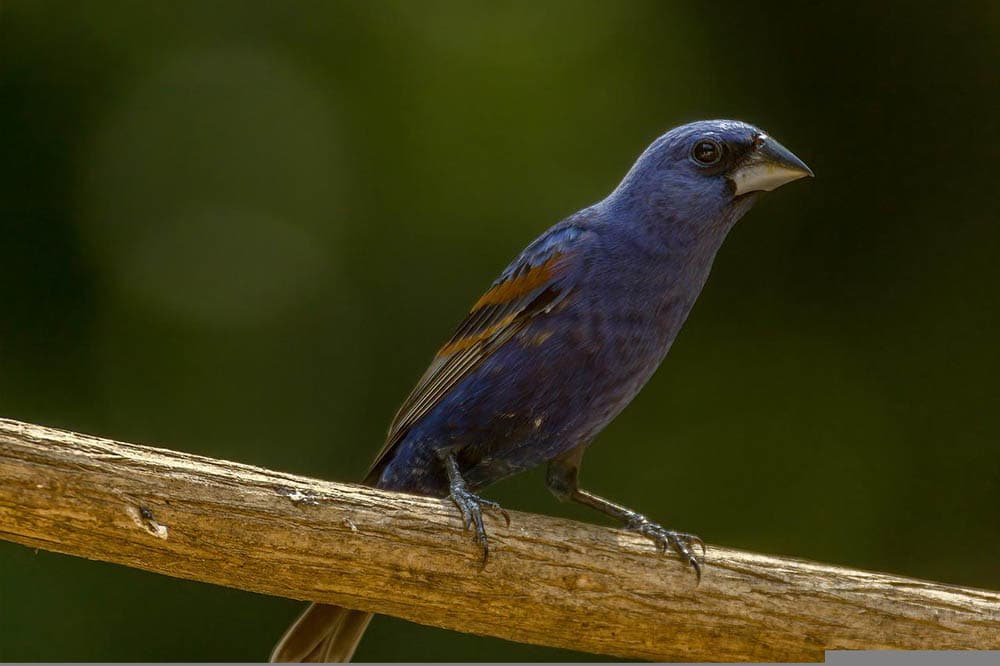
According to the Oklahoma Ornithological Society’s Bird Records Committee, 480 species of bird are documented officially within the state of Oklahoma. Of course, not all these birds are going to be commonly seen in your backyard.
Some backyard species are so well-known, they are easy to recognize, while a variety of others can be a bit more difficult to pin down. For those that would like to put up bird feeders or simply bird-watch from the comfort of their home, we’ve made a list of the most common backyard birds you will find here in Oklahoma.

The 32 Most Common Backyard Birds in Oklahoma
1. American Robin
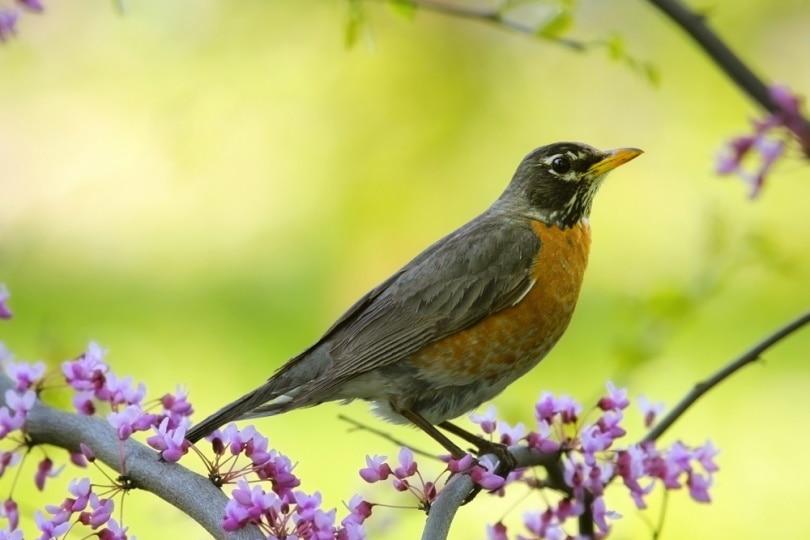
| Scientific Name: | Turdus migratorius |
| Wingspan: | 12-15.7 inches |
| Length: | 8-11 inches |
| Weight: | 2.7-3.0 oz |
The American Robin is one of the most popular backyard birds in the United States. This migratory songbird can be found in Oklahoma all year round in a variety of habitats throughout the state. Robins may be observed alone but will occasionally be seen in flocks of 50 or more birds. Robins love feasting on earthworms, insects, and fruit and tend to stay on or within 10 feet of the ground to feed.
2. American Goldfinch
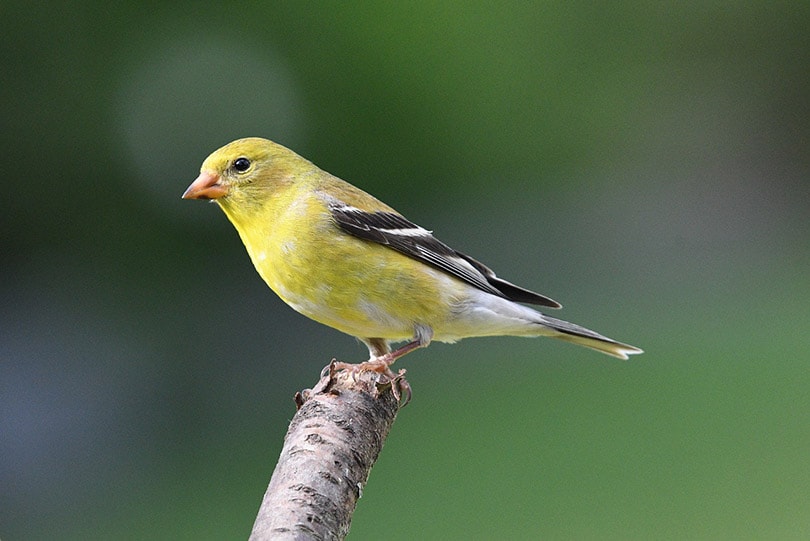
| Scientific Name: | Spinus tristis |
| Wingspan: | 7.5 -8.7 inches |
| Length: | 4.3 -5.1 inches |
| Weight: | 0.4-0.7 oz |
The American Goldfinch is found statewide throughout Oklahoma. During the spring and summer, males sport a very bright, vibrant yellow coloration. These birds are found statewide in Oklahoma but will frequent residential areas and urban environments more so in the wintertime.
Their habitat consists of woodland edges, gardens, and parks. They forage for seeds, insects, and berries but will prefer thistle and black-oil sunflower seeds in backyard feeders.
3. Northern Cardinal
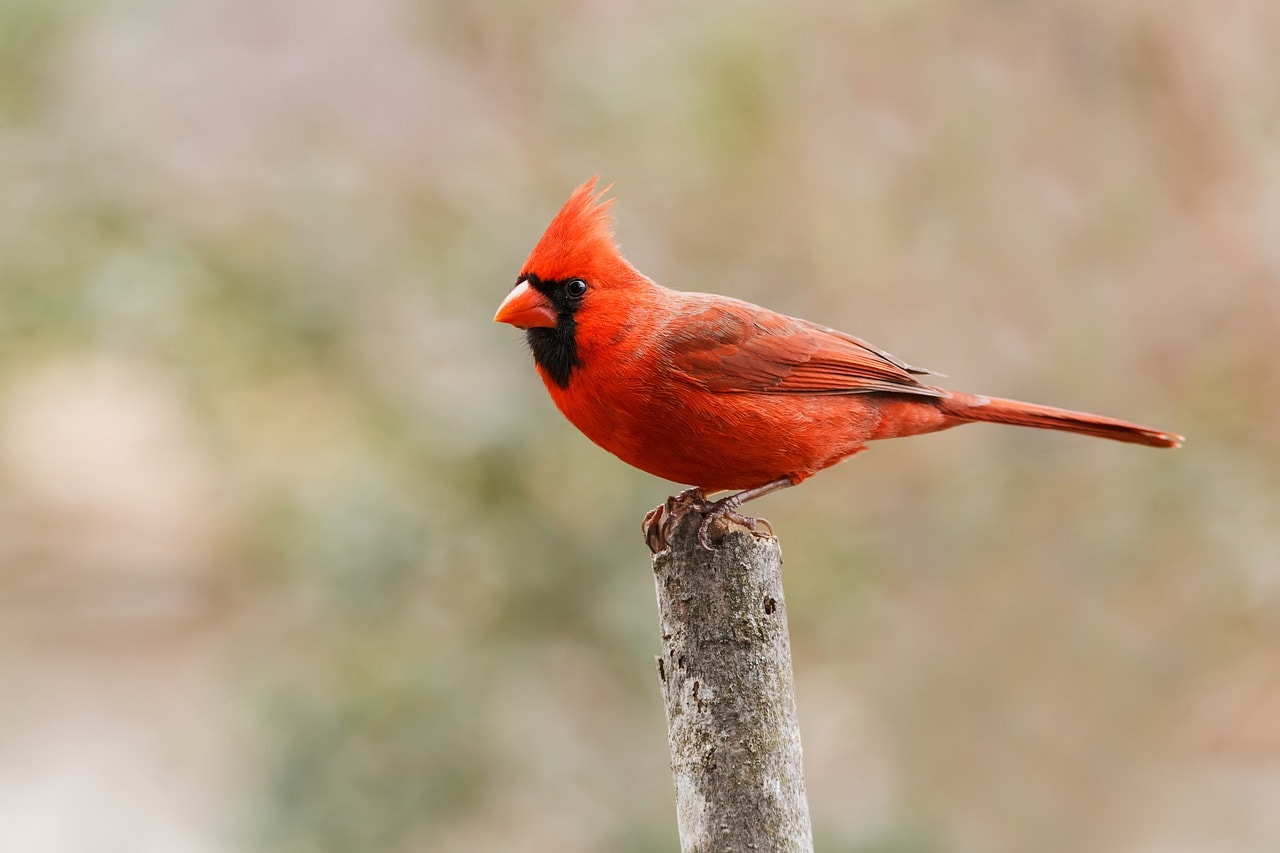
| Scientific Name: | Cardinalis cardinalis |
| Wingspan: | 9.8-12.2 inches |
| Length: | 8.3-9.1 inches |
| Weight: | 1.5-1.7 oz |
One of the most beautiful red birds in Oklahoma is the Northern Cardinal. They are commonly seen in residential areas and urban settings that have trees and shrubbery. They like areas with dense vegetation to forage and are common in the woodlands, shrublands, and near forest edges.
Northern Cardinals forage for seeds, insects, and berries but very much enjoy black-oil sunflower seeds, safflower seeds, millet, and milo in bird feeders. These beautiful birds are very popular amongst backyard bird watchers and can be found in Oklahoma all year round. The western portion of the panhandle is the only area in Oklahoma where the Northern Cardinal cannot be found.
4. Blue Jay
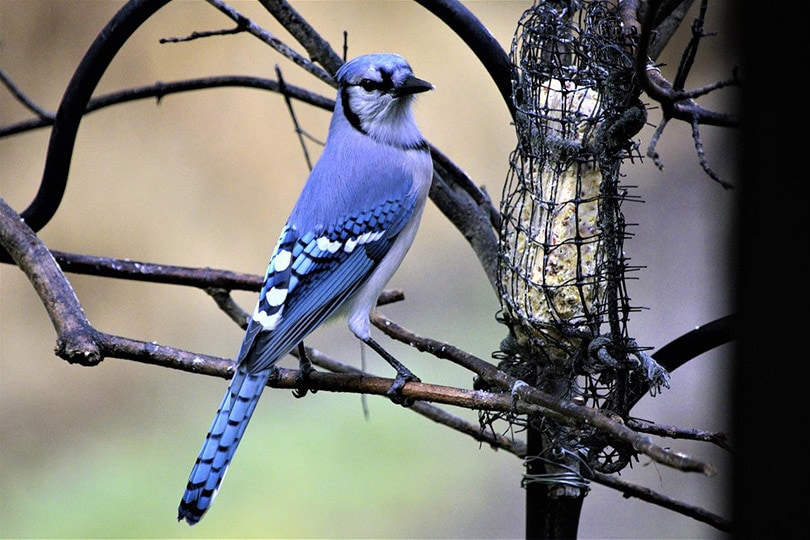
| Scientific Name: | Cyanocittacristata |
| Wingspan: | 13-17 inches |
| Length: | 10-12 inches |
| Weight: | 2.5-3.5 oz |
Though rare in the western portion of the panhandle, Blue Jays are found throughout most of the state. They are found in a variety of forest types and frequent residential and urban areas that have mature trees. A Blue Jay’s diet consists primarily of insects, acorns, and seeds. They will much enjoy bird feeders with black-oil sunflower seeds, peanuts, corn, suet, and other nut varieties.
5. American Crow
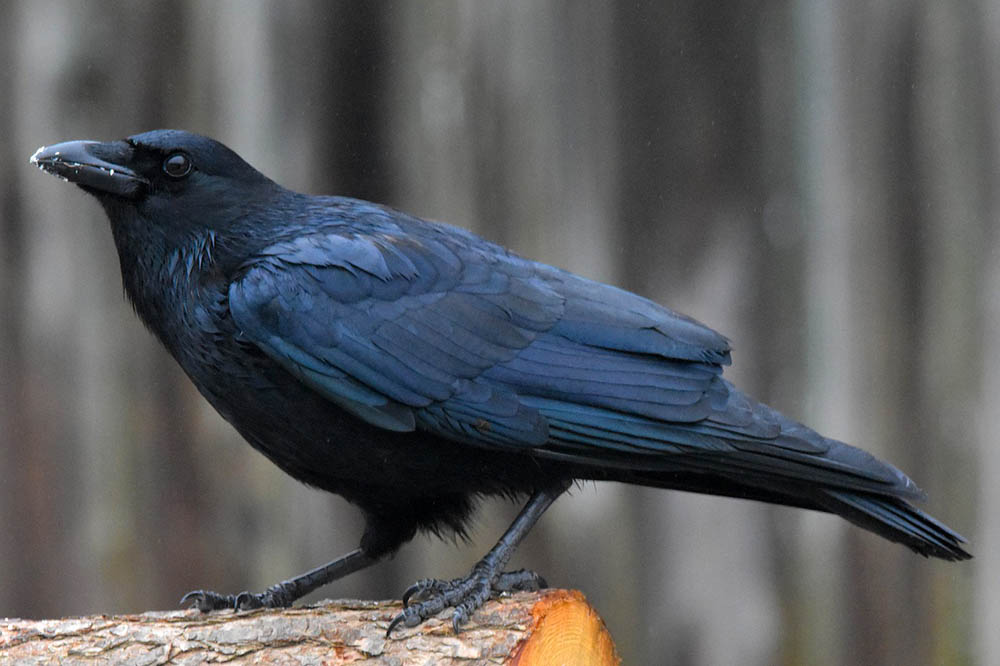
| Scientific Name: | Corvus brachyrhynchos |
| Wingspan: | 33.5-39.4 inches |
| Length: | 15.8-21 inches |
| Weight: | 11 -22 oz |
Crows are incredible birds that are highly social and very intelligent. They are found in small groups that typically consist of about 3 to 15. They are common all over the United States and are found in Oklahoma all year round. In the wild they have a very diverse diet, these birds will scavenge and forage for insects, nuts, seeds, acorns, and even small rodents and reptiles.
American Crows are commonly found in backyards either on the ground or in the trees. They travel far and wide and reside in a variety of different habitats. They are no strangers to urban and residential areas that offer up food sources.
6. Eastern Bluebird

| Scientific Name: | Sialia sialis |
| Wingspan: | 9.8-12.6 inches |
| Length: | 6-8 inches |
| Weight: | 1.0-1.1 oz |
One of the most common Oklahoma songbirds is the Eastern Bluebird. These birds like to nest in cavities and will commonly use old woodpecker nests. Their diet consists primarily of insects, caterpillars, beetles, and grasshoppers. They may not be drawn to bird feeders, but backyard observers wanting to attract the Eastern Bluebird can place nesting boxes on the property.
7. Downy Woodpecker
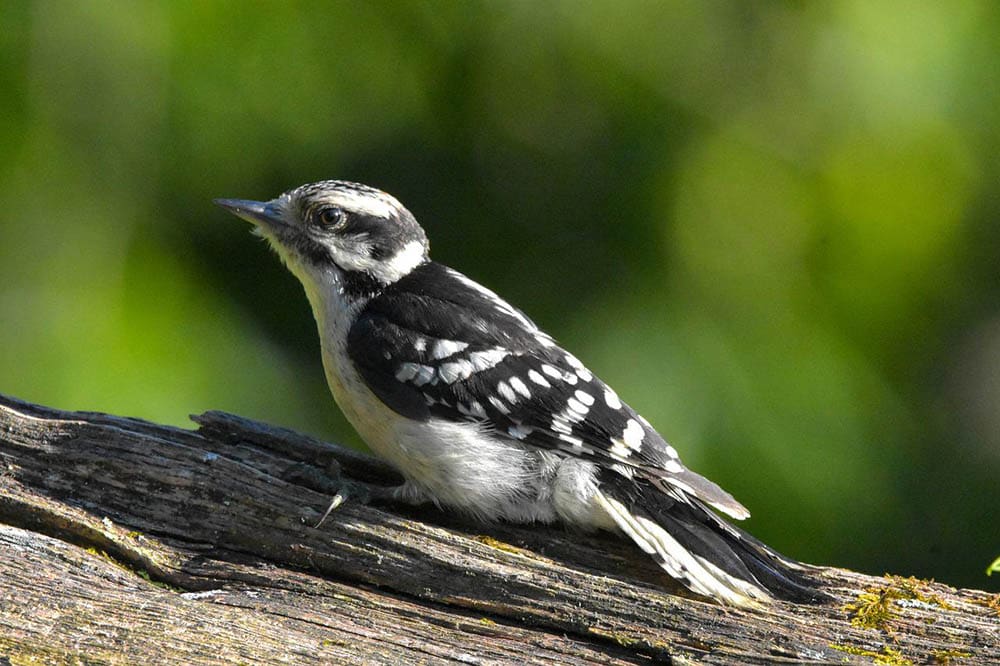
| Scientific Name: | Picoides pubescens |
| Wingspan: | 9.8-11.8 inches |
| Length: | 5.5-6.7 inches |
| Weight: | 0.7-1.0 oz |
Downy Woodpeckers are as common in urban and residential areas as they are in forests and woodland habitats. They strongly resemble the Hairy Woodpecker but their bill is much shorter and more dainty. This species is found statewide throughout Oklahoma and is a non-migratory bird.
8. Red-bellied Woodpecker
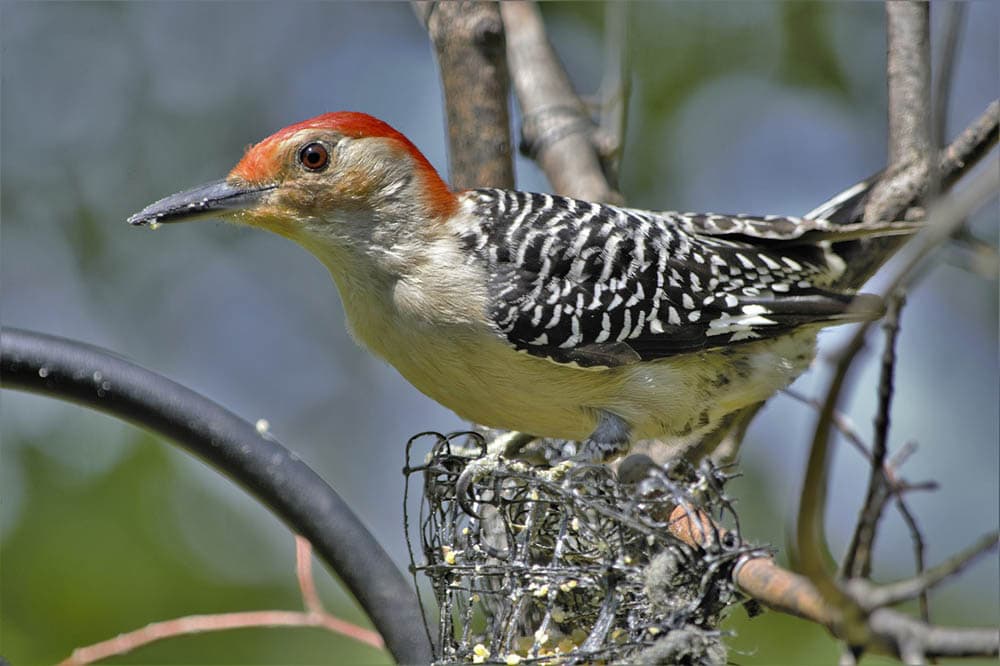
| Scientific Name: | Melanerpes carolinus |
| Wingspan: | 13.0-16.5 inches |
| Length: | 9-9.5 inches |
| Weight: | 2.0-3.2 oz |
Red-bellied Woodpeckers are close in size to the American Robin and tend to stick close to mature trees either in the forest or in urban and residential areas. They will either be observed alone or in pairs. This species’ diet consists mainly of insects, fruits, and seeds. From feeders, they enjoy suet, raisins, and black-oil sunflower seeds from the feeders. They typically do not migrate and are found statewide in Oklahoma during the wintertime.
9. Red-winged Blackbird
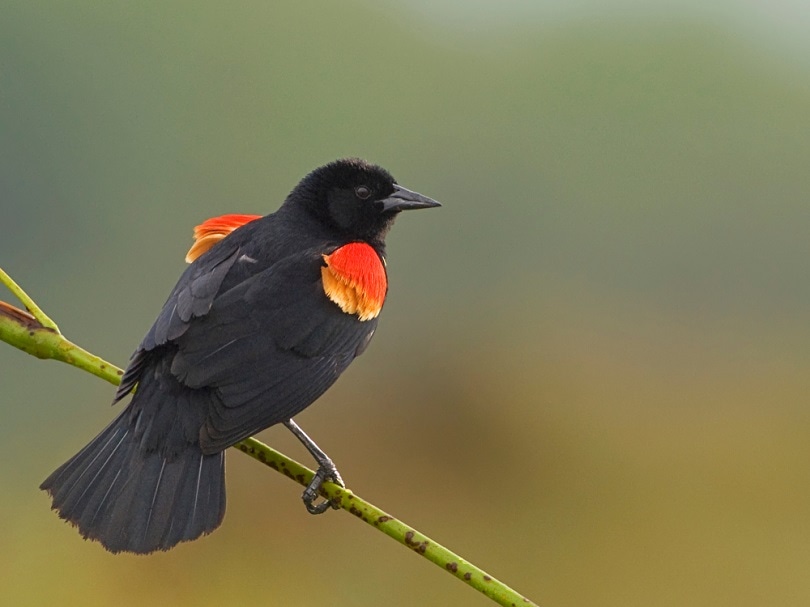
| Scientific Name: | Agelaius phoeniceus |
| Wingspan: | 12.2-15.7 inches |
| Length: | 6.7-9.1 inches |
| Weight: | 2-3 oz |
The Red-winged Blackbird is found throughout the entire state of Oklahoma. In winter they are known to frequent the urban and residential neighborhoods. Their habitat consists of marshes, meadows, and croplands. They forage the ground for seeds, insects, and grain. To attract this species to backyard bird feeders, millet, milo, black oil, and striped sunflower seeds are the way to go.
10. Tufted Titmouse

| Scientific Name: | Baeolophus bicolor |
| Wingspan: | 7.9-10.2 inches |
| Length: | 5.5-6.3 inches |
| Weight: | 0.6-0.9 oz |
The Tufted Titmouse is a songbird that tends to travel in small groups. They sport a distinct, prominent crest. They are common in forests and woodlands and within Oklahoma, Tufted Titmice reside all over except for the panhandle and the far western portion of the state. These little birds feast on insects, seeds, small fruits, and acorns. They enjoy black oil-sunflower seeds, suet, and miracle meal in backyard feeders.
11. Mourning Dove
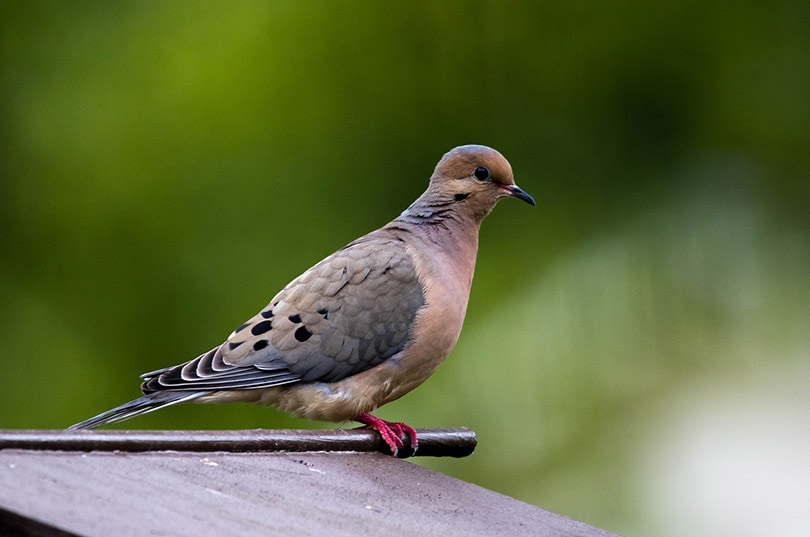
| Scientific Name: | Zenaida macroura |
| Wingspan: | 15-18 inches |
| Length: | 9.1-13.4 inches |
| Weight: | 3.0 -6.0 oz |
The Mourning Dove is a very well-known bird that is found throughout the United States. They are migratory birds that migrate twice per year, in the spring and fall.Mourning Doves can be found statewide in Oklahoma. They are unique in that they are monogamous during the mating season and both parents care for the young. They are commonly seen in pairs perched on telephone wires, fence lines, bird feeders, or on the ground foraging for seeds.
12. Common Grackle
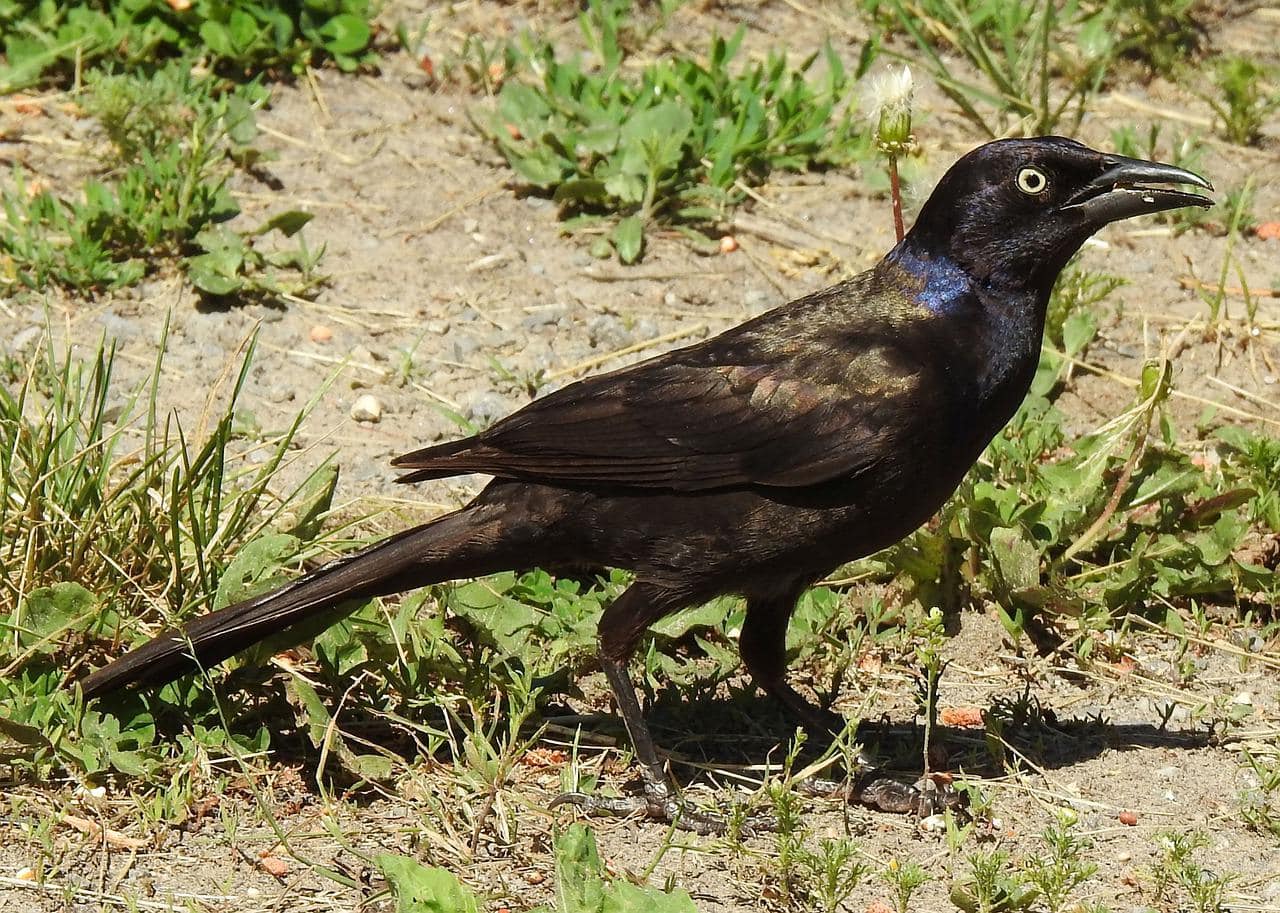
| Scientific Name: | Quiscalus quiscula |
| Wingspan: | 14.2-18.1 inches |
| Length: | 11.0-13.4 inches |
| Weight: | 2.6-5.0 oz |
Due to their looks, the Common Grackle is frequently mistaken for different species of blackbirds. These birds are found throughout the entire state of Oklahoma in a variety of habitats. They tend to forage the ground in search of food sources. Their primary diet consists of insects, earthworms, seeds, and grains. They are known for hanging out in parking lots scavenging for any leftovers that are thrown out.
13. Carolina Chickadee
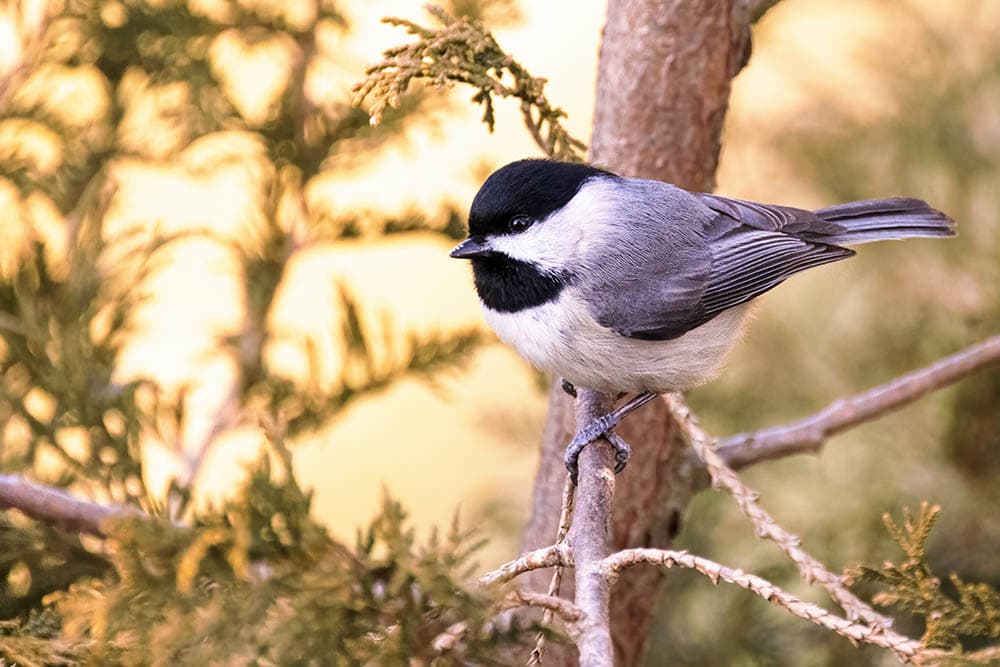
| Scientific Name: | Poecile carolinensis |
| Wingspan: | 5.9-7.9 in |
| Length: | 3.9-4.7 in |
| Weight: | 0.3-0.4 oz |
A common visitor to urban and residential areas, the Carolina Chickadee is found in most of Oklahoma, except for the panhandle. These birds typically travel in small groups of approximately 3 to 8 birds. Their typical diet consists of insects and seeds. During the winter months, they travel in mixed flocks with other species like Nuthatches, Titmice, and Brown Creepers.
14. Brown-headed Cowbird
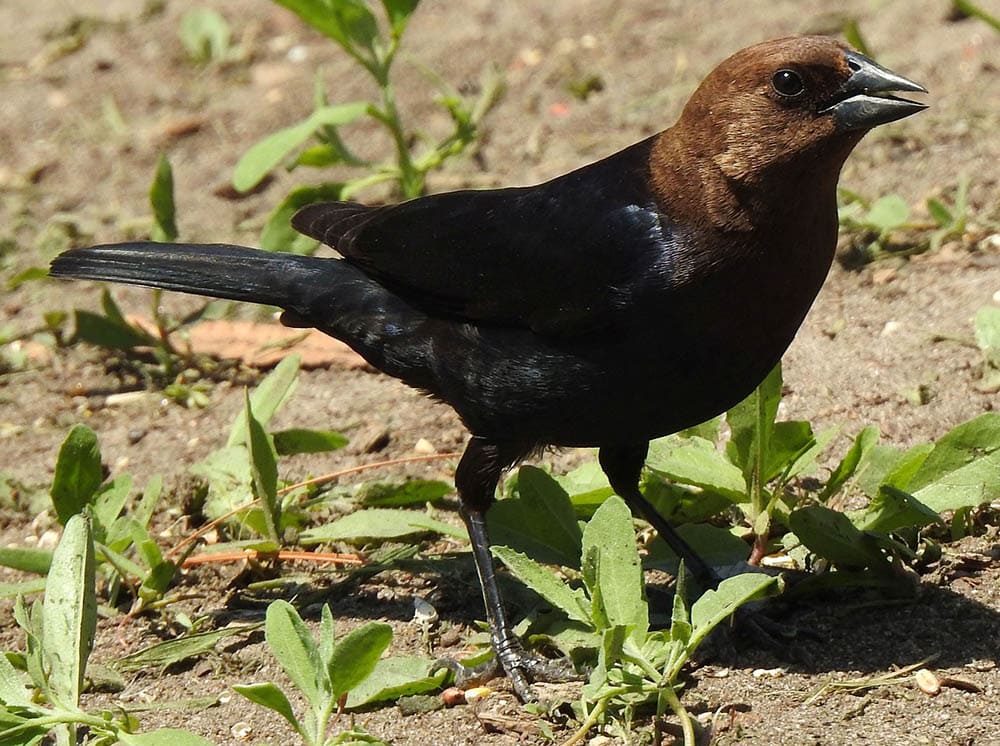
| Scientific Name: | Molothrus ater |
| Wingspan: | 14.2 inches |
| Length: | 7.3-8.7 inches |
| Weight: | 1.3-1.8 oz |
The Brown-headed Cowbird gets its name for two reasons. To state the obvious, it has a brown head. The “cowbird” part actually comes from the fact that this species tends to frequent pastures and feedlots of cattle and horses.
One of the most interesting aspects of this bird is they are nomads that will follow herds of bison across the plains. They aren’t just found out in the country though; they can be found in the backyards of residential areas quite frequently. Brown-headed Cowbirds are permanent residents of Oklahoma and are found throughout the state.
15. Eurasian Collared Dove

| Scientific Name: | Streptopelia decaocto |
| Wingspan: | 13-14 inches |
| Length: | 11.4-11.8 inches |
| Weight: | 4.9-6.3 oz |
The Eurasian Collared-Dove is not a species that is native to Oklahoma or even the United States. They are actually native to Europe and Asia but were accidentally introduced into the Bahamas in the 1970s and soon spread across North America. At this point, their range encompasses most of the southeastern United States. They are found statewide throughout Oklahoma.
16. Barn Swallow

| Scientific Name: | Hirundo rustica |
| Wingspan: | 11.4-12.6 inches |
| Length: | 5.9-7.5 inches |
| Weight: | 0.6-0.7 oz |
Anyone in a rural area is going to be familiar with the Barn Swallow. Though they do like to remain on the outskirts, they can still be observed in residential areas. These birds are found throughout the United States, including Oklahoma during their breeding season. They are well known for nesting in barns, under bridges, in garages, and other manmade structures. Anyone that has encountered a Barn Swallow that has a nest nearby, knows they are highly protective of those nests.
17. Northern Mockingbird

| Scientific Name: | Mimus polyglottos |
| Wingspan: | 12-14 inches |
| Length: | 8-10 inches |
| Weight: | 1.6-2 oz |
The Northern Mockingbird is quite common in urban settings, though their natural habitats are woodlands and shrublands. They aren’t heavily attracted to bird feeders but do like to have easy access to water. They are found statewide throughout Oklahoma but are much less common in the panhandle.
18. Northern Flicker

| Scientific Name: | Colaptes auratus |
| Wingspan: | 16.5-20 inches |
| Length: | 11-12 inches |
| Weight: | 4-6 oz |
Northern Flickers are woodpeckers that come into Oklahoma during the winter. There are two different types of Northern Flicker. First, the yellow-shafted flicker is found statewide but is more common in the central to the eastern portion of Oklahoma. Then there is the red-shafted flicker, which is less common and is typically only seen in the western portion of the state.
19. House Finch
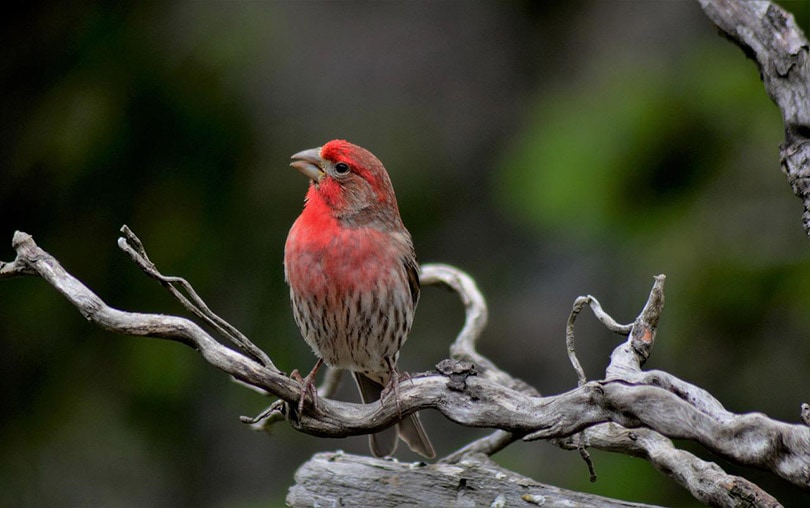
| Scientific Name: | Haemorhous mexicanus |
| Wingspan: | 8-10 inches |
| Length: | 5-5.5 inches |
| Weight: | 0.6-0.9 oz |
The House Finch was first documented in Oklahoma during the 1980s. They can be found in urban and residential areas as well as on agricultural land. They were native to the western United States but were introduced to the eastern portion, as well as Hawaii. Their diet consists of vegetation including seeds, berries, buds, and parts of flowers.
20. Painted Bunting

| Scientific Name: | Passerina ciris |
| Wingspan: | 4.7-5.5 inches |
| Length: | 4-5 inches |
| Weight: | 0.5-0.7 oz |
The Painted Bunting is common in the Southeast United States and is found throughout Oklahoma during its breeding season. They don’t make it all the way into the panhandle and like to remain in brushy areas and on the edges of woodlands. These birds are a bit harder to observe, as they can be a bit more reclusive and like to remain under dense cover. They mostly forage on the ground but will also forage up in shrubs and lower trees. When they migrate, they sometimes forage along with Indigo Buntings in mixed flocks.
21. Ruby-throated Hummingbird
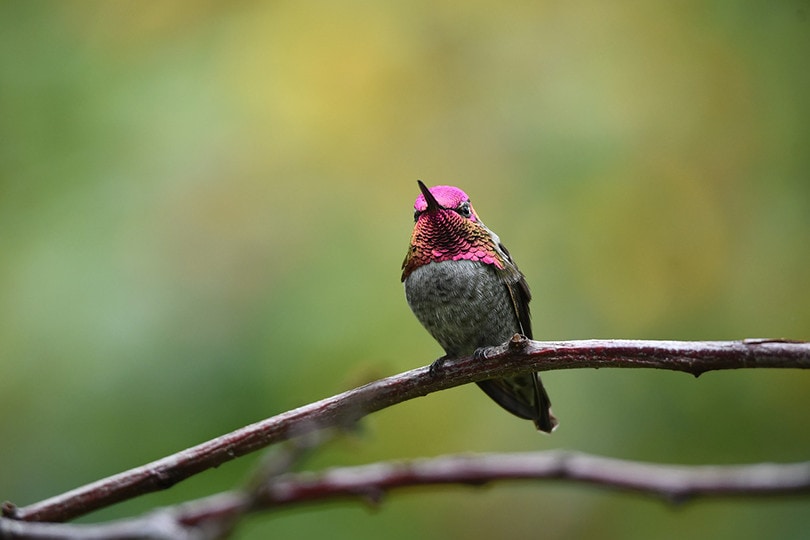
| Scientific Name: | Archilochus colubris |
| Wingspan: | 3-4.5 inches |
| Length: | 2.8-3.5 inches |
| Weight: | 0.1-0.2 oz |
The Ruby-throated Hummingbird may very well be the most sought-after backyard bird for those that love to admire the beauty of birds from the comfort of their home. Hummingbird feeders are quite popular and draw in these precious, speedy little birds. They are considered Neotropical migrants, meaning they nest in North America and winter in Central America. The species typically show up in Oklahoma around mid-April.
22. Carolina Wren
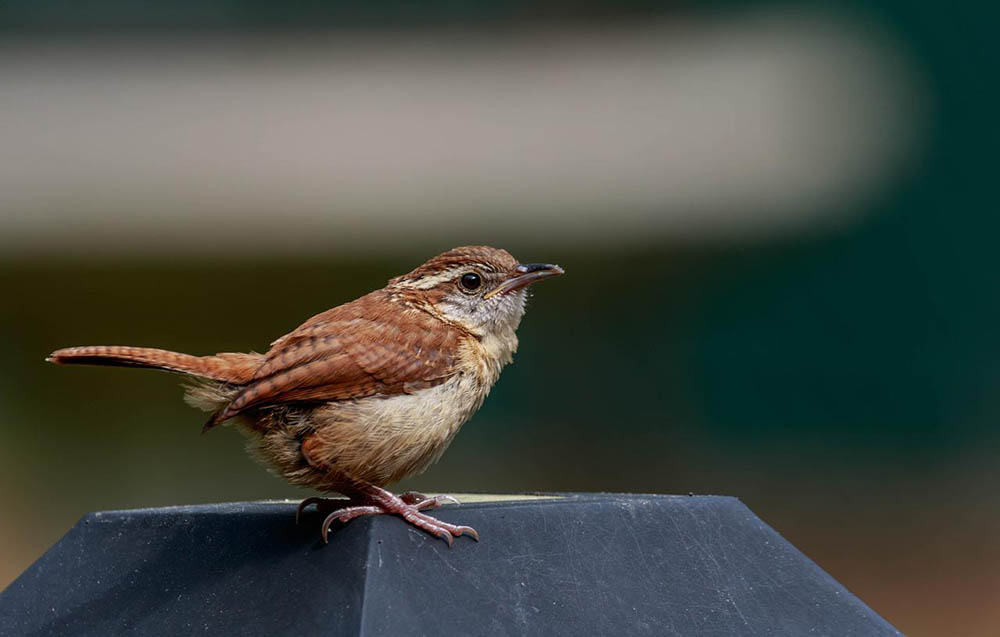
| Scientific Name: | Thryothorus ludovicianus |
| Wingspan: | 11-12 inches |
| Length: | 4.7-5.5 inches |
| Weight: | 0.6-0.8 oz |
The reddish-brown Carolina Wren is found in the eastern two-thirds of Oklahoma year-round. They inhabit forests and woodlands but like to visit residential neighborhoods that have mature trees. They are observed either individually or in pairs. These birds forage for insects, spiders, and poison ivy berries but enjoy eating suet, miracle meal, shelled black-oil sunflower seeds, and chopped apples offered in feeders.
23. Eastern Phoebe
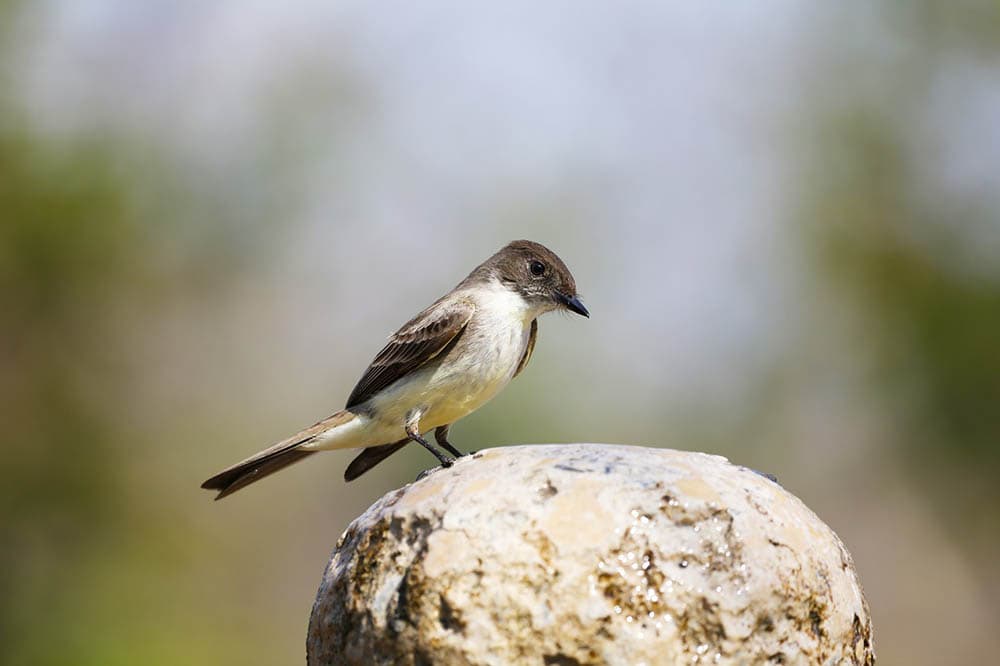
| Scientific Name: | Sayornis phoebe |
| Wingspan: | 10-11 inches |
| Length: | 5.5-6.7 inches |
| Weight: | 0.6-0.7 oz |
The Eastern Phoebe is one of the most common brown birds in Oklahoma that can be found year-round in the southeastern portion of the state but extend throughout the rest of the land area during the breeding season. Their diet consists mostly of berries and insects. Like barn swallows, the Eastern Phoebe tends to nest in manmade structures like barns or under bridges.
24. House Sparrow
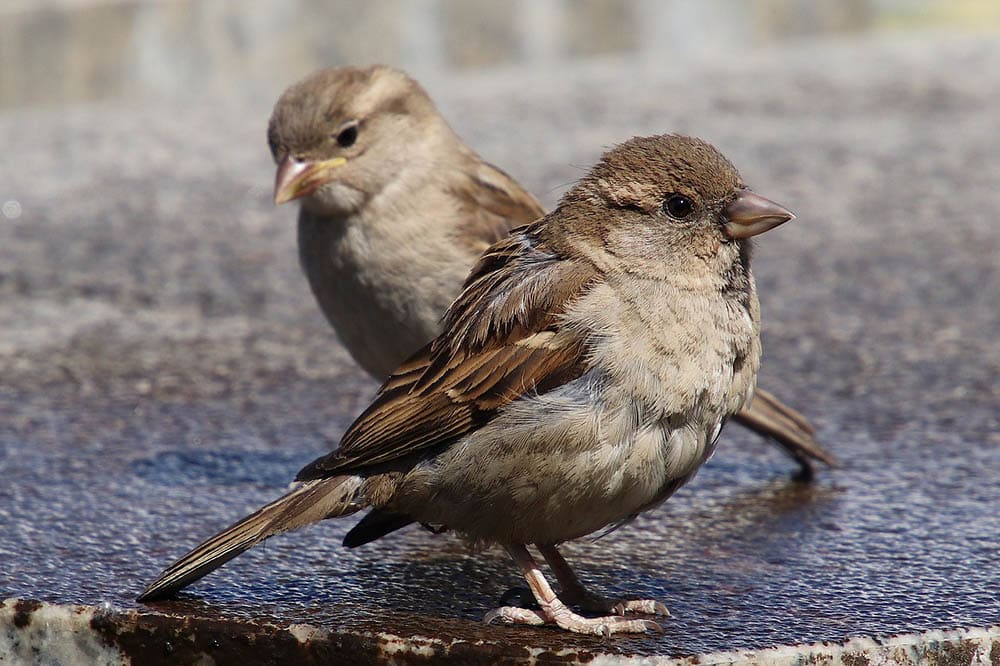
| Scientific Name: | Passer domesticus |
| Wingspan: | 7.5-10 inches |
| Length: | 6-7 inches |
| Weight: | 0.9-1.1 oz |
House Sparrows are very common birds that are found year-round throughout the entire United States and up into Canada. These adaptable little birds tend to keep close to humans and can even thrive in city environments. Their diet consists mainly of seeds and waste grain. Whether you’re in rural Oklahoma or reside within the urban areas, you’re bound to run into this bird.
25. Dark-eyed Junco

| Scientific Name: | Junco hyemalis |
| Wingspan: | 7-10 inches |
| Length: | 5.5-6.3 inches |
| Weight: | 0.6-1.1 oz |
The Dark-eyed Junco is very common in Oklahoma during the wintertime. The species is found in a variety of habitats that have trees and shrubbery. You’re most likely to see them in backyards in residential neighborhoods that have plenty of mature trees. They are found throughout the entire state of Oklahoma from early October through early April. They eat a diet consisting of small seeds and can be drawn to feeders with millet, milo, thistle, and finely cracked corn.
26. Eastern Meadowlark
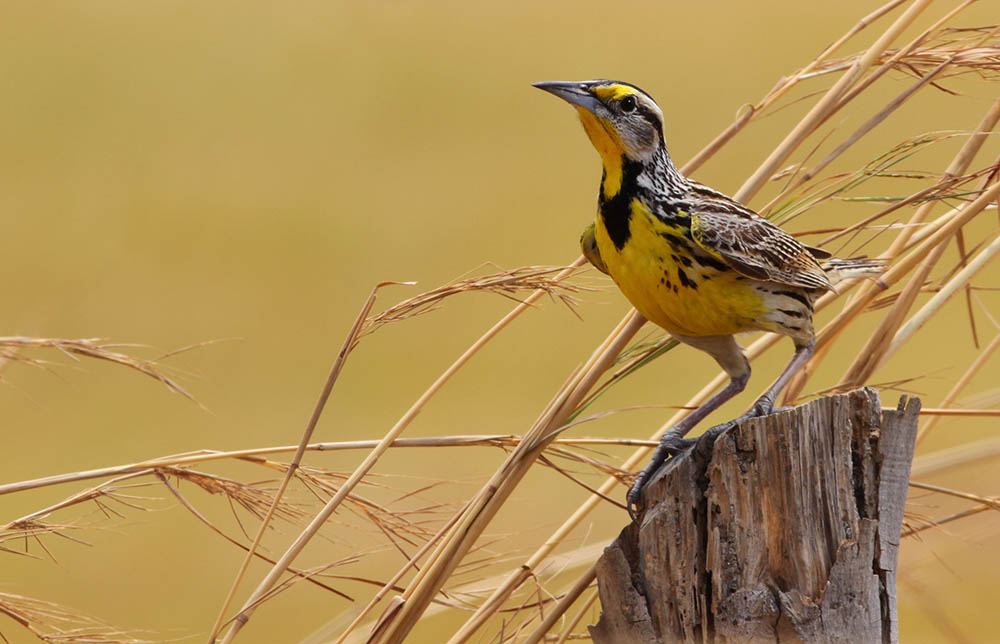
| Scientific Name: | Sturnella magna |
| Wingspan: | 13.8-15.8 inches |
| Length: | 7.5-10.2 inches |
| Weight: | 3.2-5.3 oz |
The Eastern Meadowlark inhabit fields, pastures, croplands, and the prairie. Though statewide in Oklahoma, sightings are much scarcer in the panhandle. They primarily feed on grasshoppers, crickets, beetles, spiders, and some vegetation but with feeders, they are drawn to millet, black-oil sunflower seeds, and cracked corn.
27. Song Sparrow
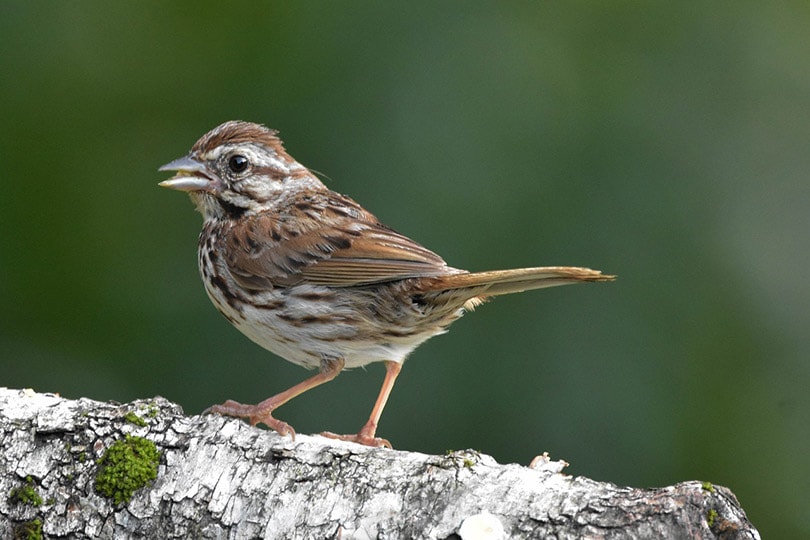
| Scientific Name: | Melospiza melodia |
| Wingspan: | 7.1-9.4 inches |
| Length: | 4.7-6.7 inches |
| Weight: | 0.4-1.9 oz |
Another Oklahoma songbird is the Song Sparrow. These birds are found statewide from the middle of October through late April and are often observed near water. They tend to inhabit the cattail marshes and willow thickets. They feed primarily on insects and seeds and will go for milo, millet, and black-oil sunflower seeds in backyard bird feeders. Like most other songbirds, Song Sparrows will use their song to attract mates and defend their established territory.
28. Cedar Waxwing

| Scientific Name: | Bombycilla cedrorum |
| Wingspan: | 9-12 inches |
| Length: | 5.5-6.7 inches |
| Weight: | Up to 1.1 oz |
The Cedar Waxwing is a songbird that is found in the eastern two-thirds of Oklahoma. They are commonly mistaken for Bohemian Waxwings, but this is no worry in Oklahoma since the Bohemian does not normally travel into the state.
Cedar Waxwings stick to thickets and plenty of shrub cover. Their primary diet consists of fruit and the occasional insects. Backyard observers would need to add some dried fruit to their feeders to attract this species. It’s more likely they’ll be drawn into fruit-bearing trees and water.
29. Indigo Bunting

| Scientific Name: | Passerina cyanea |
| Wingspan: | 7.5-8.7 inches |
| Length: | 4.7-5.1 inches |
| Weight: | 0.4-0.6 inches |
In the eastern United States, the Indigo Bunting is one of the most common songbirds. The deep blue colored males are typically the easiest to recognize in both coloration and the fact that females tend to stay hidden away caring for their young. Indigo Buntings forage all over insects, seeds, and berries. They are typically alone in the summer and flocks during the winter. These birds can be found throughout most of Oklahoma during the breeding season but are an incredibly rare sight in the western portion and the panhandle.
30. White-throated Sparrow

| Scientific Name: | Zonotrichia albicollis |
| Wingspan: | 7.9-9.1 inches |
| Length: | 6.3 to 7.1 inches |
| Weight: | 0.7-0.8 inches |
Found in Oklahoma from late October through early May, the White-throated Sparrow is commonly seen in residential neighborhoods that have mature trees and shrubbery. The species sticks close to forests and streams, feasting on ground insects and small seeds. Millet and black-oil sunflower seeds are the most likely to attract them to feeders.
31. Pileated Woodpecker
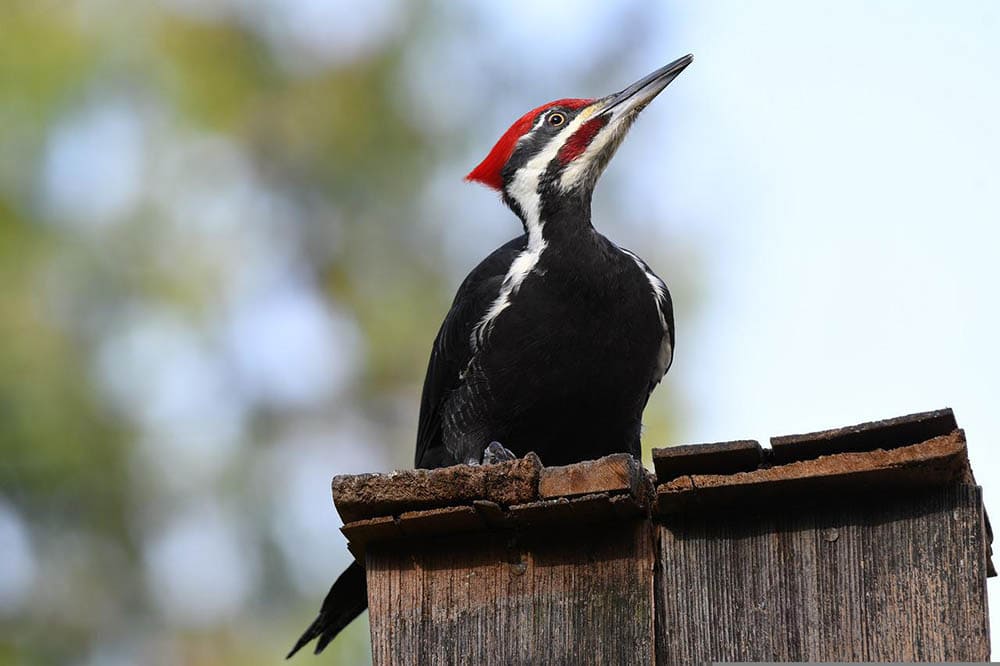
| Scientific Name: | Dryocopus pileatus |
| Wingspan: | 26-30 inches |
| Length: | 15-19 inches |
| Weight: | 7.9 to 14.1 oz |
The large, Pileated Woodpecker keeps forests full of mature trees and is quite rare in Oklahoma except for the far southeastern corner that is thick with forests. They are found year-round in these areas, as they are non-migratory. They’ll occasionally be seen at feeders within their habitat range but tend to stick to heavily wooded rural areas rather than coming into urban environments.
32. White-breasted Nuthatch
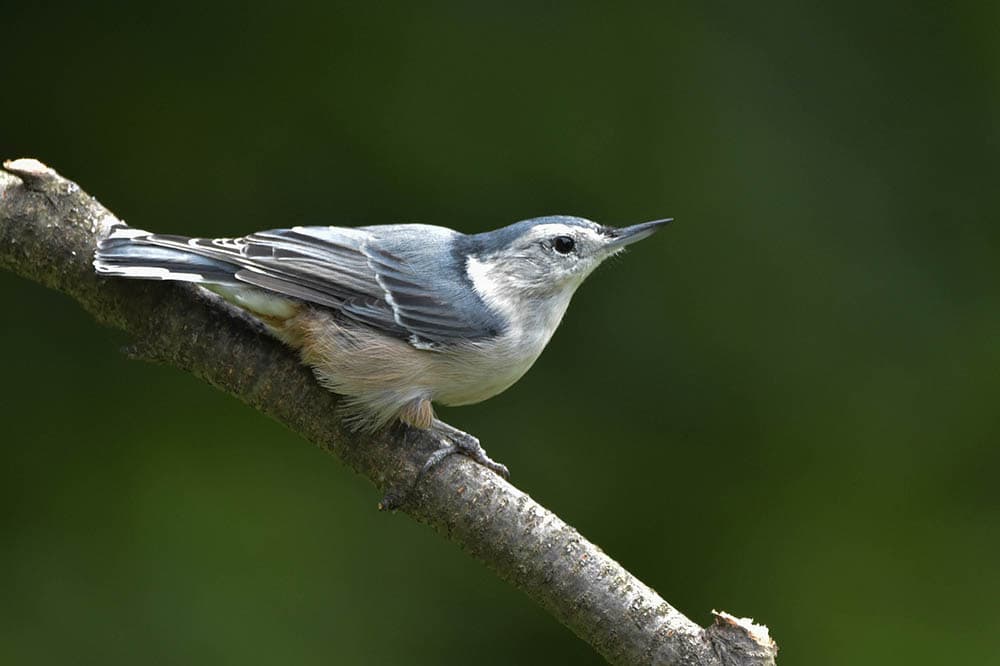
| Scientific Name: | Sitta carolinensis |
| Wingspan: | 7-8 inches |
| Length: | 3-4 inches |
| Weight: | 0.7-0.8 oz |
The White-breasted Nuthatch can be found year-round in the eastern two-thirds of Oklahoma but is only observed in the western portion during the wintertime. They like oak and pine forests and frequent heavily treed residential neighborhoods. They feast on insects, acorns, and seeds and will be attracted to black-oil sunflower seeds, peanuts, and suet in the backyard feeders.

Conclusion
Oklahoma has no shortage of backyard birds to observe and invite into your yard with feeders. The state has some permanent residents and some that only visit during certain seasons. There are quite a few species that are only found in certain areas of Oklahoma, due to the diverse habitats found throughout the state.
Featured Image Credit By dalspaugh, Pixabay
Table of Contents
- The 32 Most Common Backyard Birds in Oklahoma
- 1. American Robin
- 2. American Goldfinch
- 3. Northern Cardinal
- 4. Blue Jay
- 5. American Crow
- 6. Eastern Bluebird
- 7. Downy Woodpecker
- 8. Red-bellied Woodpecker
- 9. Red-winged Blackbird
- 10. Tufted Titmouse
- 11. Mourning Dove
- 12. Common Grackle
- 13. Carolina Chickadee
- 14. Brown-headed Cowbird
- 15. Eurasian Collared Dove
- 16. Barn Swallow
- 17. Northern Mockingbird
- 18. Northern Flicker
- 19. House Finch
- 20. Painted Bunting
- 21. Ruby-throated Hummingbird
- 22. Carolina Wren
- 23. Eastern Phoebe
- 24. House Sparrow
- 25. Dark-eyed Junco
- 26. Eastern Meadowlark
- 27. Song Sparrow
- 28. Cedar Waxwing
- 29. Indigo Bunting
- 30. White-throated Sparrow
- 31. Pileated Woodpecker
- 32. White-breasted Nuthatch
- Conclusion
About the Author Robert Sparks
Robert’s obsession with all things optical started early in life, when his optician father would bring home prototypes for Robert to play with. Nowadays, Robert is dedicated to helping others find the right optics for their needs. His hobbies include astronomy, astrophysics, and model building. Originally from Newark, NJ, he resides in Santa Fe, New Mexico, where the nighttime skies are filled with glittering stars.
Related Articles:
Monocular vs Telescope: Differences Explained (With Pictures)
10 Types of Hummingbirds in Arkansas (With Pictures)
8 Types of Hummingbirds in Nebraska (With Pictures)
5 Types of Hummingbirds in Idaho (With Pictures)
3 Types of Hummingbirds in Mississippi (With Pictures)
8 Types of Hummingbirds in Kansas (With Pictures)
5 Types of Hummingbirds in West Virginia (With Pictures)
5 Types of Hummingbirds in Ohio (With Pictures)
